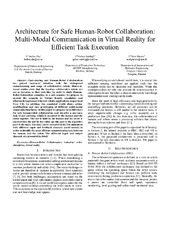Blar i forfatter "Shu, Beibei"
-
The application of open access middleware for cooperation among heterogeneous manufacturing systems
Arnarson, Halldor; Solvang, Bjørn; Shu, Beibei (Chapter; Bokkapittel, 2020)The vision behind industry 4.0 is to create even smarter manufacturing facilities. Industry 4.0 includes both hardware and software components, which are expected to seamlessly interact in a secure manner. Thus, machinery and software components from different manufacturers should be able to communicate in a common language. Such a challenge is typically met by introducing a “middleware” to serve ... -
Architecture for Safe Human-Robot Collaboration: Multi-Modal Communication in Virtual Reality for Efficient Task Execution
Shu, Beibei; Sziebig, Gabor; Pieters, Roel (Peer reviewed; Chapter; Bokkapittel, 2019-08-01)Task-sharing and Human-Robot Collaboration has gained increased attention with the widespread commissioning and usage of collaborative robots. However, recent studies show that the fenceless collaborative robots are not as harmless as they look like. In order to study Human-Robot Interaction scenarios, in a safe manner, we propose to execute the scenario in Virtual Reality simulation and afterwards ... -
Architectures and technologies for increased agility in small-scale manufacturing systems
Shu, Beibei (Doctoral thesis; Doktorgradsavhandling, 2022-06-16)<p>The rapid booming of industry 4.0 technologies has been boosting further development of industrial manufacturing systems in the recent two decades. An increasing number of disruptive yet enabling technologies are becoming available for industrial applications. However, while the factories becoming more complex, a proliferation of incompatible systems that have been developed by different vendors ... -
Collaboration with High-Payload Industrial Robots: Simulation for Safety
Shu, Beibei; Sziebig, Gabor (Journal article; Tidsskriftartikkel; Peer reviewed, 2018-12-15)<p>When operators and industrial robots are sharing the same task, there are multiple factors, which effect if a system is safe for the human operator or not. In general this is solved by introducing Collaborative Robot for cooperation, but what happens when we would extend our already existing production facilities with newer comfort features?</p> <p>In this paper we propose to include industrial ... -
Common Educational Teleoperation Platform for Robotics Utilizing Digital Twins
Kaarlela, Tero; Arnarson, Halldor; Pitkäaho, Tomi; Shu, Beibei; Solvang, Bjørn; Pieskä, Sakari (Journal article; Tidsskriftartikkel; Peer reviewed, 2022-07-18)The erratic modern world introduces challenges to all sectors of societies and potentially introduces additional inequality. One possibility to decrease the educational inequality is to provide remote access to facilities that enable learning and training. A similar approach of remote resource usage can be utilized in resource-poor situations where the required equipment is available at other premises. ... -
Human-Robot Collaboration: Task Sharing Through Virtual Reality
Shu, Beibei; Sziebig, Gabor; Pieskä, Sakari (Peer reviewed; Book; Chapter, 2018-12-31)Collaborative Robots provide many possibilities, when it comes to Human-Robot Collaboration. Until now, these approaches are usually custom made, sensor-integrated solutions, where the robot's safety controller ensures the safety of the human worker. These solutions are according to today's rules and standards. We propose to extend these solutions with including Virtual Realty as a sensor and to ... -
Introduction of cyber-physical system in robotized press-brake line for metal industry
Shu, Beibei; Sziebig, Gabor; Solvang, Bjørn (Journal article; Tidsskriftartikkel; Peer reviewed, 2018-02-11)Bin picking is a typical work, which is easy to automate up to a given complexity of the work-piece dimensions. In case of casted work-pieces, the dimensions are most of the time not accurate enough for an industrial robot to be able to pick it up without additional sensors/intelligence. In this paper we introduce a cyber-physical system, where all sensors, actuators, machines and industrial robot ... -
An Introduction of the Role of Virtual Technologies and Digital Twin in Industry 4.0
Azarian, Mohammad; Yu, Hao; Solvang, Wei Deng; Shu, Beibei (Journal article; Tidsskriftartikkel; Peer reviewed, 2020-01-03)It is inevitable that technological improvements have affected human’s life in any aspect to a large extent. Automation, artificial intelligence, robotics, etc., are some advances contributed to the fourth industrial revolution: Industry 4.0. Despite there are still many arguments, Internet of Things (IoT) and Cyber Physical Systems (CPS) have been widely acknowledged as the main fundaments of ... -
Technology Modules Providing Solutions for Agile Manufacturing
Deniša, Miha; Ude, Aleš; Simonič, Mihael; Kaarlela, Tero; Pitkäaho, Tomi; Pieskä, Sakari; Arents, Janis; Judvaitis, Janis; Ozols, Kaspars; Raj, Levente; Czmerk, András; Dianatfar, Morteza; Latokartano, Jyrki; Schmidt, Patrick Alexander; Mauersberger, Anton; Singer, Adrian; Arnarson, Halldor; Shu, Beibei; Dimosthenopoulos, Dimosthenis; Karagiannis, Panagiotis; Ahonen, Teemu-Pekka; Valjus, Veikko; Lanz, Minna (Journal article; Tidsskriftartikkel; Peer reviewed, 2023-09-01): In this paper, we address the most pressing challenges faced by the manufacturing sector, particularly the manufacturing of small and medium-sized enterprises (SMEs), where the transition towards high-mix low-volume production and the availability of cost-effective solutions are crucial. To overcome these challenges, this paper presents 14 innovative solutions that can be utilized to support ... -
To Measure Relative Permittivity of Atmospheric Ice Using Frequency Sweep
Mughal, Umair Najeeb; Shu, Beibei (Journal article; Tidsskriftartikkel; Peer reviewed, 2016-10-31)The use of AD59333 IC for detecting atmospheric ice and atmospheric ice type was evaluated in this article. A prototype circuit was developed and was tested using a frequency sweep from 40 Hz to 20 kHz. The IC was calibrated using 100 kΩ resistor. The real and imaginary components of discrete Fourier transform were recorded at each frequency increment in order calculate the gain factor at each ...


 English
English norsk
norsk








